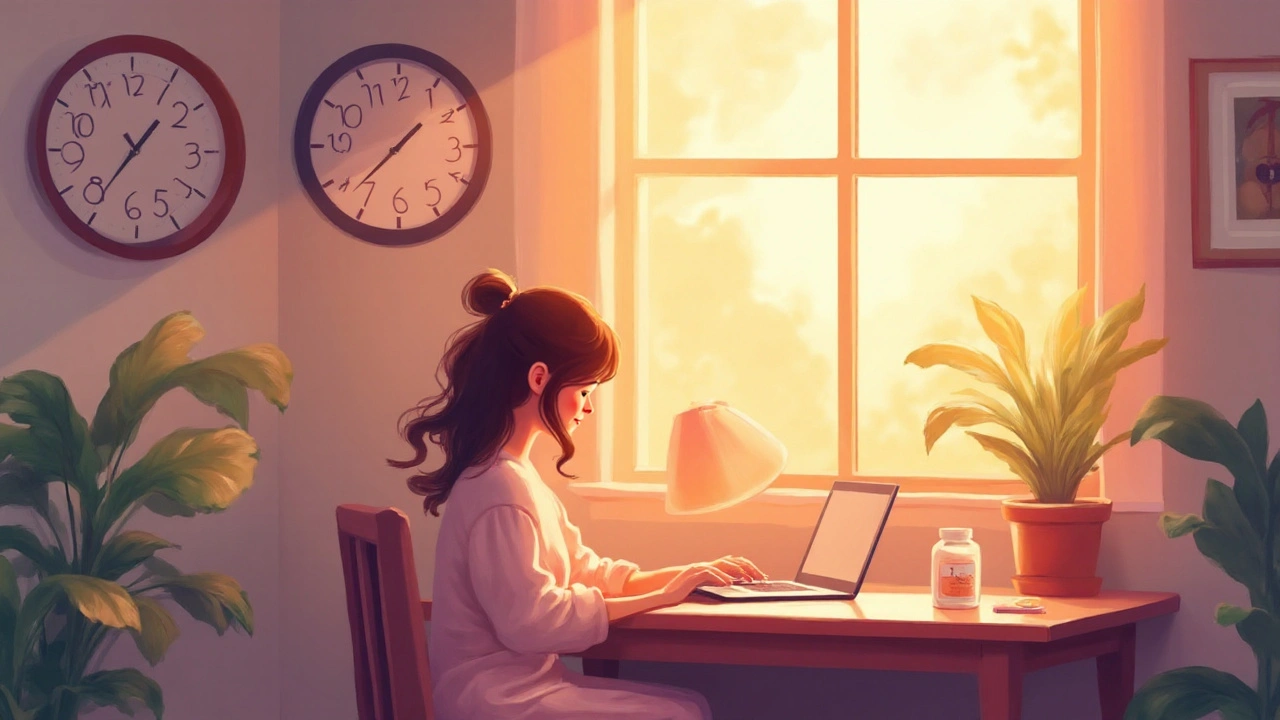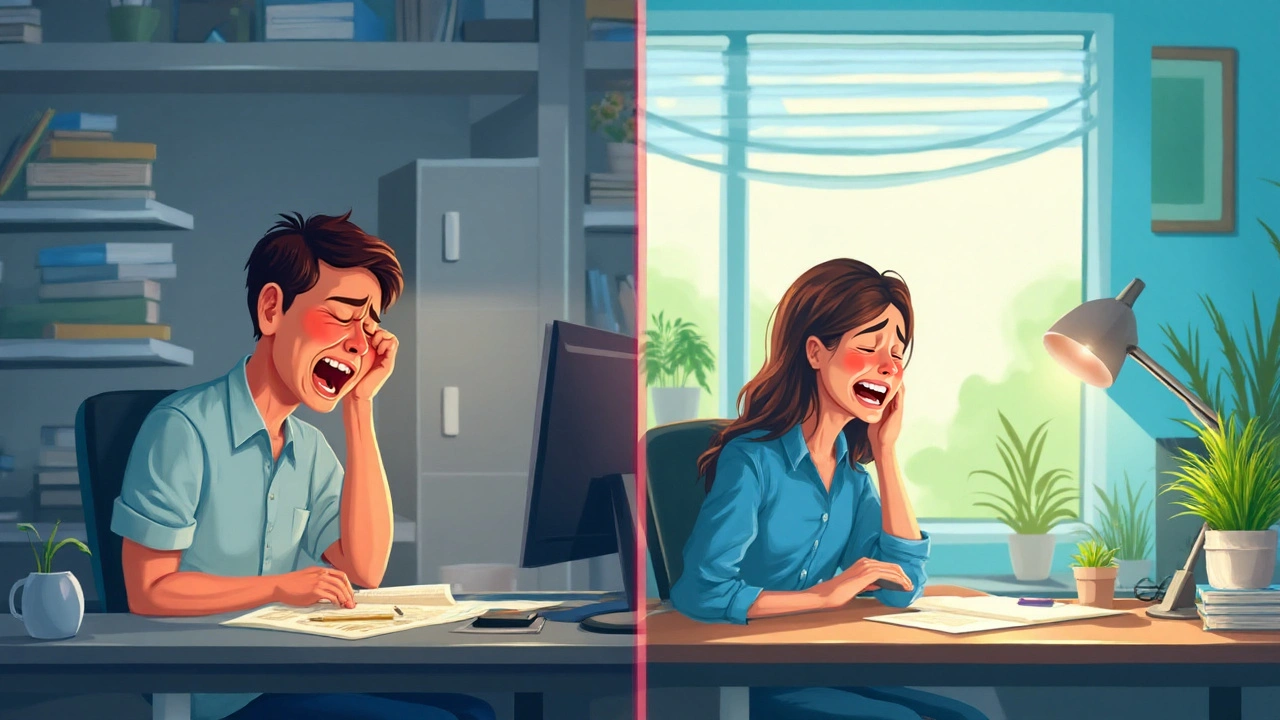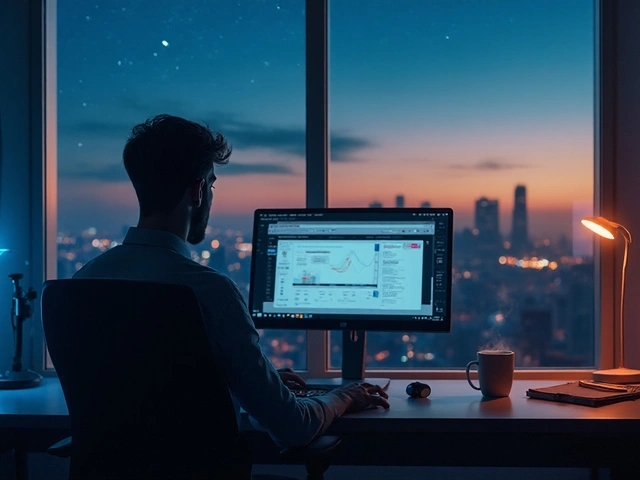Delayed Sleep Phase Syndrome is a circadian rhythm sleep disorder that pushes an individual’s natural sleep window 2‑4hours later than the societal norm. About 0.15% of adults worldwide experience symptoms severe enough to disrupt daily obligations, especially the typical 9‑to‑5 schedule.
TL;DR
- DSPS shifts your internal clock, making early mornings painful.
- Identify triggers: blue‑light exposure, inconsistent bedtime, stress.
- Use light therapy in the morning, melatonin at night, and solid sleep hygiene.
- Negotiate flexible working hours or remote options with your employer.
- Track progress with a sleep diary or actigraphy to fine‑tune your routine.
What Causes the Delay? The Role of the Circadian Rhythm
At the heart of DSPS lies the circadian rhythm, a 24‑hour biological clock regulated by the suprachiasmatic nucleus in the brain. Light entering the eyes resets this clock daily; when exposure happens late at night, the rhythm slides forward, delaying melatonin release and making sleep onset later.
Genetics, chronic caffeine use, and irregular social schedules can exacerbate the shift. For a software developer who codes late into the night, the combination of blue‑light screens and caffeine spikes often creates a perfect storm for DSPS.
Career Consequences: Performance, Productivity, and Mental Health
The mismatch between your body’s clock and office hours hits the work-life balance hard. Studies from the Australian Sleep Association show that employees with DSPS report 25% lower perceived productivity and a 30% increase in burnout scores compared to peers.
Beyond numbers, the real impact appears in missed meetings, foggy cognition, and strained relationships with managers who may mistake lateness for lack of commitment. The stress of constantly fighting your clock also raises anxiety levels, feeding a vicious cycle that deepens the sleep disorder.
Aligning Your Schedule: Light Therapy, Melatonin, and Sleep Hygiene
Three evidence‑based pillars can reset the clock:
- Light therapy - exposure to bright white light (10,000lux) for 20‑30minutes within 30minutes of waking advances the circadian phase.
- Melatonin supplement - a low dose (0.5‑1mg) taken 4‑5hours before desired bedtime signals the body to start winding down.
- Rigorous sleep hygiene - consistent bedtime, screen curfew, cool dark bedroom, and avoidance of alcohol before sleep.
Implementing these steps in a coordinated fashion yields the best results. For example, a graphic designer in Sydney who began a morning light box routine, took melatonin at 10pm, and turned off all devices by 9:30pm saw sleep onset improve from 2am to 11:30pm within three weeks.
| Strategy | Typical Onset of Effect | Key Requirement | Potential Side Effects |
|---|---|---|---|
| Light Therapy | 1‑2weeks | 10,000lux box, morning use | Headache, eye strain (rare) |
| Melatonin | Few nights | 0.5‑1mg dose, evening intake | Drowsiness next day (if overdosed) |
| Sleep Hygiene | 2‑4weeks | Consistent schedule, screen‑free zone | None if followed correctly |

Negotiating Flexible Working Hours
While medical strategies shift your clock, workplace flexibility can bridge the gap instantly. Approach your manager with a clear plan: propose a core‑hours window (e.g., 11am‑4pm) and offer to make up any missed time via early evenings or weekends.
Many Australian companies now embrace flexible working hours as part of wellbeing programs. Highlight how aligning work with your optimal alertness periods can boost output - a point backed by a 2023 QLD health‑sector audit that reported a 12% rise in project delivery speed after introducing flexible rosters for night‑type employees.
Time Management and Burnout Prevention
Even with a shifted schedule, you still need solid time management habits. Use the "two‑minute rule" for quick tasks, batch similar work to reduce context switching, and schedule high‑cognition tasks (like strategic planning) during your peak alertness window - often mid‑morning for DSPS sufferers who start their day later.
Burnout risk spikes when you constantly compensate for missed mornings. Incorporate micro‑breaks, limit after‑hours emails, and set a firm “lights‑out” time to protect your sleep window. If you notice mood dips or irritability, that’s a cue to reassess workload and possibly seek mental‑health support.
Monitoring Progress: Sleep Diary and Actigraphy
Objective feedback helps fine‑tune your regimen. A simple sleep diary records bedtime, wake time, light exposure, and caffeine intake. Over a month, patterns emerge that point to hidden triggers.
For tech‑savvy professionals, actigraphy - a wrist‑worn sensor that tracks movement and estimates sleep stages - offers a data‑rich alternative. A study by the University of Sydney found actigraphy users reduced DSPS symptom severity by 18% compared with diary‑only participants.
Related Concepts and Next Steps
Understanding DSPS opens doors to a broader conversation about chronotype (natural morningness or eveningness), shift work challenges, and overall mental health resilience. Readers might later explore:
- How to assess your chronotype using the Morningness‑Eveningness Questionnaire.
- Employer policies for shift‑work accommodations.
- Mindfulness techniques that improve sleep quality.
Each of these topics builds on the core strategies outlined here, forming a comprehensive toolkit for anyone juggling a demanding career with a delayed internal clock.

Frequently Asked Questions
Can DSDS be cured or only managed?
There is no permanent cure, but most people achieve functional remission by combining light therapy, melatonin, strict sleep hygiene, and workplace accommodations. Consistency is key; occasional lapses can cause the clock to drift back.
How soon will light therapy start working?
Most users notice a shift of 15‑30 minutes after one to two weeks of daily morning exposure. Full adjustment-typically 1‑2hours-may take 3‑4weeks.
Is melatonin safe for long‑term use?
Low‑dose melatonin (≤1mg) is considered safe for most adults when taken short‑term. Long‑term data are limited, so periodic reviews with a healthcare professional are recommended.
What if my employer refuses flexible hours?
Document your condition with a medical note and reference local workplace health regulations. If negotiations fail, consider roles offering remote or staggered schedules, or consult an occupational health specialist for advice.
Can I use a fitness tracker instead of actigraphy?
Many modern fitness trackers include actigraphy‑grade motion sensors and can provide decent sleep estimates. Look for devices that offer a “sleep stage” breakdown and exportable data for more accurate analysis.
How does DSPS affect mental health?
Chronic misalignment between internal and external clocks raises cortisol levels, which can increase anxiety and depressive symptoms. Addressing sleep timing often improves mood and reduces stress.
Are there apps that help manage DSPS?
Yes. Apps like SleepCycle, Chronotype tracker, and Bright Light scheduler help log sleep patterns, remind you of light‑therapy sessions, and suggest optimal bedtime windows based on your data.
What lifestyle changes complement medical strategies?
Limit caffeine after 2pm, keep a regular exercise routine (preferably morning), avoid heavy meals close to bedtime, and create a calming pre‑sleep ritual (reading, gentle stretching).


Kelvin Murigi
September 25, 2025 AT 22:41First off, you can absolutely tame that delayed clock with a disciplined routine. Start each day by stepping in front of a 10,000‑lux light box within half an hour of waking – the brighter, the better. Pair that with a micro‑dose of melatonin (0.5‑1 mg) about four to five hours before you intend to sleep, and you’ll signal your brain to shift back. Keep your bedroom cool, dark, and free of screens after 9 PM to lock in the hygiene gains. Finally, sit down with your manager armed with a simple proposal: core hours from 11 AM to 4 PM and make up the rest in the evenings.
ahmad matt
September 29, 2025 AT 10:01Wow, you sound like a corporate wellness brochure that never left the HR department.
kristine ayroso
October 2, 2025 AT 21:21Honestly, i think the biggest thing is to stop feeling ashamed about needing a different schedule. Your body isn’t broken, it’s just on a diffrent rhythm. Talk to your boss with confidence – you’re not asking for a favour, you’re protecting productivity. And remember, caffeine after 2pm is just sabotage.
Ben Small
October 6, 2025 AT 08:41Take this as a challenge: turn that night‑owl energy into a secret weapon. Schedule deep‑work tasks for when you’re naturally most alert – usually mid‑morning for us night‑types. Then crush the boring admin stuff during the lull. You’ll surprise yourself with the output.
Dylan Hilton
October 9, 2025 AT 20:01Let’s break down the grammar of the TL;DR list: each bullet should end with a period for consistency, and “Use light therapy in the morning, melatonin at night, and solid sleep hygiene.” could be tightened to “Use morning light therapy, evening melatonin, and solid sleep hygiene.” Also, avoid dangling modifiers – “light therapy – exposure to bright white light (10,000lux) for 20‑30minutes within 30minutes of waking advances the circadian phase.” should read “Exposure to bright white light (10,000 lux) for 20‑30 minutes within 30 minutes of waking advances the circadian phase.” Small tweaks make the guide look more professional.
Christian Andrabado
October 13, 2025 AT 07:21Grammar check: “light therapy - exposure” needs an em dash, not a hyphen, and “20‑30minutes” misses a space before “minutes”. Also, “the clock” should be preceded by “your” for clarity.
Chidi Anslem
October 16, 2025 AT 18:41From a philosophical angle, DSPS teaches us that the world’s 9‑to‑5 tyranny is a social construct, not a biological inevitability. By aligning work with personal chronotype we respect the diversity of human rhythms. This perspective can inspire companies to redesign policies, fostering inclusion beyond mere accommodation. It also invites individuals to view their condition not as a flaw but as a cue for deeper self‑knowledge.
Holly Hayes
October 20, 2025 AT 06:01Honestly, if you cant fit into the standard schedule youre just being lazy and need to get your act together.
Penn Shade
October 23, 2025 AT 17:21Let me set the record straight: the science is clear-light therapy works in as little as two weeks, melatonin works within a few nights, and sleep hygiene takes about a month. Anything less is just anecdotal fluff. Also, employers who refuse flexibility are violating basic occupational health guidelines in many jurisdictions. So if you’re being stonewalled, it’s a legal issue, not a personal one.
Jennifer Banash
October 27, 2025 AT 03:41Dear fellow sufferers, I must protest the casual tone of many remarks herein. While enthusiasm is commendable, propriety demands that we reference peer‑reviewed sources when we claim “25% lower productivity”. Moreover, the term “burnout” carries clinical weight and should not be wielded frivolously. Let us therefore elevate the discourse, citing the Australian Sleep Association study directly, and maintaining decorum.
Stephen Gachie
October 30, 2025 AT 15:01When confronting Delayed Sleep Phase Syndrome in a professional environment, one must adopt a multi‑pronged strategy that respects both chronobiology and organizational dynamics. First, recognize that the suprachiasmatic nucleus, the master clock, responds most robustly to short‑wavelength light; thus, a 10,000‑lux light box positioned within 30 minutes of awakening can precipitate a phase advance of roughly 0.5 hours per day. Second, synchronize melatonin administration to the endogenous dim‑light melatonin onset, typically 4–5 hours before the desired bedtime; a low dose (0.5–1 mg) mitigates the risk of residual somnolence while reinforcing the circadian signal. Third, enforce stringent sleep hygiene: a fixed sleep‑wake schedule, a screen‑curfew beginning at least an hour before lights‑out, and a bedroom environment cooled to approximately 18 °C. Fourth, document these interventions meticulously in a sleep diary or, preferably, through actigraphy; objective data empower both the individual and occupational health professionals to calibrate treatment efficacy. Fifth, approach management with a concise proposal: delineate a core‑hours window aligned with peak alertness (commonly 11 AM–4 PM for night‑type workers), and offer compensatory work during evenings or weekends to preserve total hours. Such a proposal not only demonstrates responsibility but also leverages evidence that flexible scheduling can boost productivity by up to 12 % in comparable cohorts. Sixth, incorporate cognitive‑behavioral techniques-mindfulness meditation, progressive muscle relaxation-to attenuate the hyper‑arousal often accompanying chronic sleep misalignment. Seventh, monitor caffeine intake, restricting consumption to before 2 PM to avoid further phase delays. Eighth, maintain open communication with supervisors, presenting periodic progress reports that reference quantitative improvements in sleep onset latency and subjective daytime alertness. Ninth, should institutional resistance persist, consult local labor statutes; many jurisdictions recognize circadian‑related disorders as legitimate medical conditions warranting reasonable accommodation. Tenth, cultivate peer support networks, either within the workplace or through online communities, to share strategies and mitigate the sense of isolation. Eleventh, periodically reassess the treatment regimen, as the efficacy of light therapy may wane over time, necessitating adjustments in duration or timing. Twelfth, remain vigilant for comorbidities such as anxiety or depression, which can exacerbate DSPS and demand integrated therapeutic approaches. Finally, remember that the ultimate aim transcends mere symptom suppression; it is the restoration of a harmonious alignment between internal physiology and external obligations, fostering sustained well‑being and professional fulfillment.